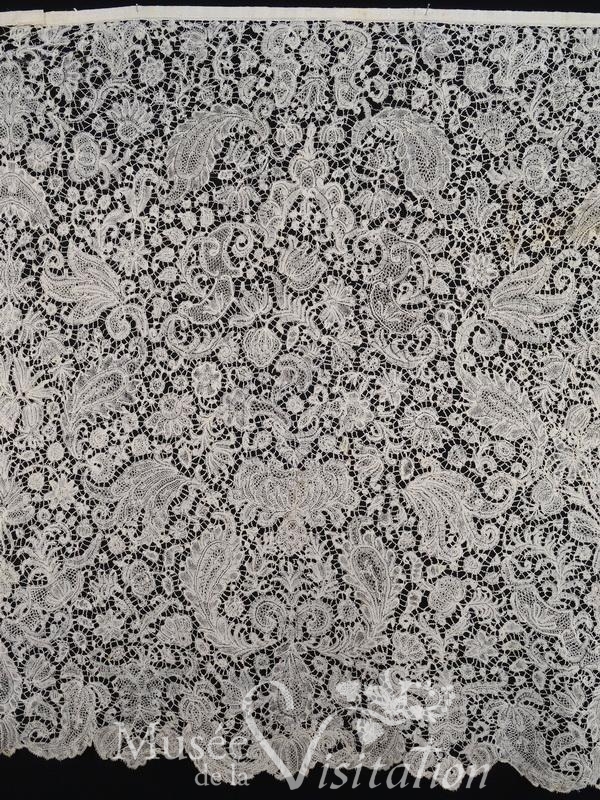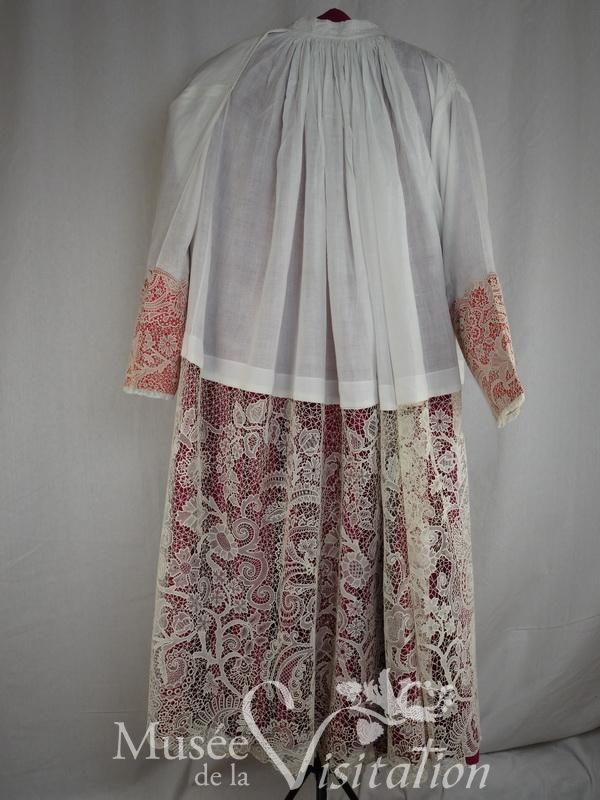 Today the word “lace” irresistibly evokes fashion. The historical reality of lace is quite different. Indeed, it was not particularly feminine since men wore it as much as women for three centuries.
Today the word “lace” irresistibly evokes fashion. The historical reality of lace is quite different. Indeed, it was not particularly feminine since men wore it as much as women for three centuries.
Worn with sleeves, collar, hair, hairstyles and dresses, lace is then the outer sign of wealth, even more so than jewelry and rich fabrics: elegance inexpressibly linked to the notion of social rank.
Lace Exhibit at Visitation Museum
Visitors can admire dresses, fans, hairstyles and other civilian accessories worn by the greatest of this world. But they can also see also the beginnings of the lace art thanks to the dress shirts worn by Saint Francis de Sales in the early years of the 17th century.
Then, the exhibit explains how the Visitation nuns who inherited these pieces gave them a second life by transforming them into uses to embellish the liturgy in their chapels.
Changes in civilian fashion have led to changes in style,techniques and use of lace in liturgical art.
As for lace’s manufacture, it was a painful job that spoiled the eyes and the back and which left time for nothing else. To feed fantasies hundreds of thousands of people worked to draw, design, execute and mount lace.
The 150 exhibits illustrate this diversity of manufacture from the 17th to the 20th century.
But the most beautiful, and the most moving for the visitor will undoubtedly be in the discovery of serrated or embroidered pieces by the Sisters: faith, self-denial and countless hours of work permeate through these works exhibited for the first time. These parts, from a stylistic and technical point of view, are as beautiful as the pieces coming out of large workshops of manufacturers.
Fashion lace
The visitor is welcomed by the Empress Eugenie, wife of Napoleon III, who poses with her ladies in a bucolic setting.
The priests and bishops, despite their special status in society, were influenced by the fashion of their time. Thus, the visitor will discover with surprise that the choir garments of the prelates under the Second Empire are embellished with the same laces as those worn at court and in salons.
What is lace?
Before going further, the visitor is invited to form the eye, including how are these “holed fabrics” made.
Thanks to the support of the video, it will include the genesis of this accessory destined to play with the light, to embellish the clothes that it covers to emphasize their richness.Unlike embroidery, lace has no support. It’s an entangling of threads requiring dexterity, patience and, above all,very many hours of manual labor. To make them, the lacemaker uses mainly fine yarns of bleached linen, sometimes wires. She executes her drawings either with the needle or with the spindles. Finally, the exhibition briefly presents how these precious and fragile luxurious accessories are washed, starched and then ironed.
 The first uses of lace in the 16th century
The first uses of lace in the 16th century
Many portraits of the time are of the great ones of this world. On the other hand, specimens are rare, time having done its work.
The Visitandines, on the other hand, have had at heart to preserve over the centuries the objects that belonged to their founder, Francis de Sales, which are relics since the latter was declared a saint by the Church. Thanks to this, the exhibition highlights gloves decorated with gold lace and silver bobbin lace, with a dress shirt of the end of the 16th century, reserved for the lords, no doubt lent to the saint to honor him.
Clothing and fashion
There are also are presented many fashion accessories decorated with lace:
Handkerchiefs, fans, umbrellas, which allow the visitor to touch the lace art.
The visitor will also discover that lace has long dressed furniture(Mirror, toilet table and even bathtubs)
The visitor also discovers the ingenuity of the Visitation nuns who re-use the lace. Here a dress became a veil for a tabernacle, there a handkerchief is used as a support for a monstrance, or a collar and a fan sheet mounted together enhance a ciborium pavilion.
Beside these laces, the convent rooms invite us to the heart of the marvelous universe of Visitandines. Basically, they use simple techniques . We discover more than mere “works of ladies”: nuns have pushed the technique to perfection, have explored it to bring it to a high degree and have developed a know-how, an excellence, with self-denial, not counting their time, and inscribing in it their practice of prayer. The interweaving of the threads invites meditation.